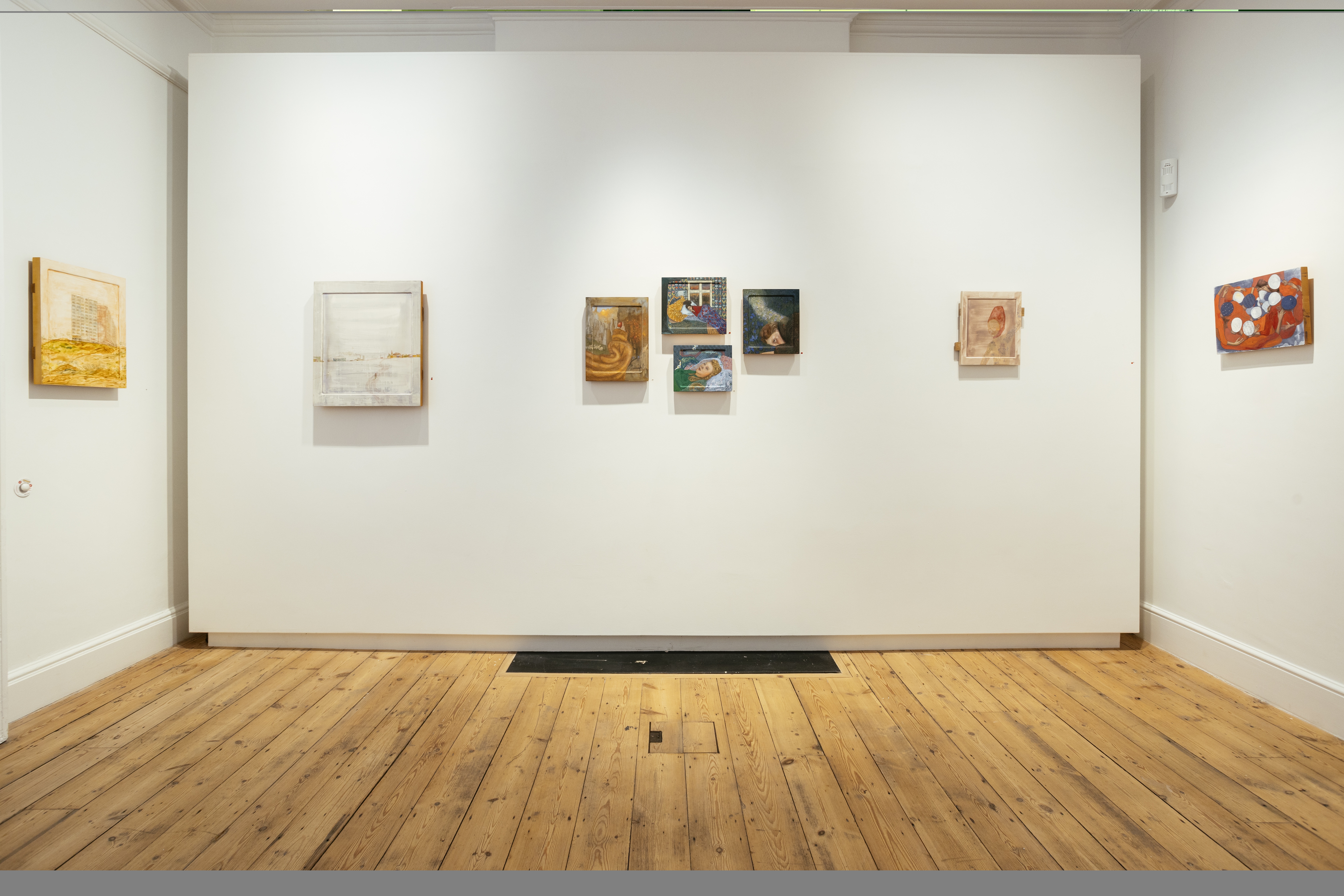
In Selo Snezhnoe (or Snowy Village), an early painting by the Russia-born British artist Veronica Smirnoff, a lonely figure crosses a snowy landscape, holding two green shopping bags. They are headed for a cluster of buildings that sink below the faint line where the land meets the sky. Off to the far left, a child tracks footprints in the fresh snow, but the fur-coated shopper follows a more well-trodden path: a washy, purple line that extends beyond the wooden panel on the gallery wall.
Paths tell stories. They are journeys inscribed on a landscape, or in the snow that settles on vast ice fields. In fact, every painting at Candida Stevens Gallery’s place – displace (where Selo Snezhnoe hangs alongside works by Smirnoff’s fellow painters, Charlotte Evans and Ben Crawford) recalls a journey of some kind. After all, each of the artists has uprooted their respective lives and transported them across the world. Born in Britain, Evans moved to the USA in 2011, and now resides in Toronto, Canada. Crawford was born in Ireland, but for the last eleven years has been living in Queensland, Australia. Smirnoff started life in Moscow, but moved to Britain as a teenager and now lives and works in London.
Separately, these artists have worn paths that criss-cross the globe, searching for home (not to mention international gallery shows). In place – displace, however, these paths converge on a single point: namely, two connected rooms at the South Kensington arts space Cromwell Place. Viewed together in this way, the painters’ works are bound by a sense of ambiguity; their geography is impossible to pin down, from the pink-hued skies of Crawford’s domestic scenes, to the patchworked nature of Evans’ dense canvases, to the liquid haze of Smirnoff’s wintry scenes.
Since moving to Australia, Ben Crawford has worked in a shipping container studio based in the Currumbin Valley, a rural area made up of subtropical rainforest and banana plantations. Compared to the place where he was brought up, this land has always been exotic and unfamiliar. Crawford’s curiosity about its natural features and inhabitants comes across in his cross-generational images, such as Briny Soldiers and Brackish Starfish, where memories from his childhood are superimposed onto a rendering of his own children playing on the beach, alongside found images, courtesy of the vast banks of public photography on websites such as Flickr. There are many years and more than 10,000 miles between the events depicted on this single canvas, but the internet helps collapse the barriers between time and place; the past catches up with the present. In another painting, The Red House (After Munch), a dark, sombre figure lurks in the shadows of the eponymous building, lending the otherwise-idyllic scene an eerie, dreamlike quality. Where (or when) has she come from? It’s hard to say.
Charlotte Evans takes a very different approach to mapping the dislocation that comes with travelling thousands of miles – first from the inner city of London to the mountains of northern Italy, and then to America and Canada. Where Crawford’s work draws on stories from the places he’s been, Evans tends to reduce what she’s seen, the local flora and fauna, into colour and form. The resulting pictures reimagine the faces of “beautiful strangers” in unearthly, saturated colours that offset the costumes they wear. Elsewhere, flowers bloom as coded references to the journey of Evans and her ancestors – a thistle represents distant Scottish heritage; ethereal dandelions symbolise hope and new growth – while tree branches and boulders melt away into abstract patterns.
By far the most compelling pictures in place – displace, though, come from Veronica Smirnoff, whose exploration of cultural identity is heightened by her reliance on ancient methods, requiring a high level of technical expertise. The exhibition of her works begins with paintings made early in her career, such as her reproduction of a snowy village, and another of a Soviet-style apartment block with shops selling milk and vodka (in actual fact, this cultural resonance was triggered by Smirnoff’s time in Berlin; as in Crawford’s work, episodes from the artist’s life are layered on top of one another). Like much of her work, these images are painted in egg tempera on textured wooden panels – boards manufactured by monasteries, intended to house religious icons. This spiritual aspect of the work is ever-present; previously, Smirnoff also worked in restoration, bringing Russian religious icons back to life, which explains her ability to grind pigment from semi-precious stones and turn it into paint, layered in bold and expressive swathes of colour.
It’s not only Smirnoff’s working methods that bear signs of her background in religious art, though. Symbolic iconography is also scattered throughout the paintings, etched into walls, woven into fabrics, and painted onto skin: snakes and apples, flowers, and short bursts of Cyrillic script. As we move further along the timeline of her career, we reach a series of paintings finished during the coronavirus pandemic. Curiously, these take on a dual aspect. On one hand, Smirnoff’s imagery becomes increasingly rich and fantastical, as if the artist was yearning to escape the tedium of nationwide lockdowns. On the other, the subjects of the portraits – the artist’s family and friends – are literally pinned down, immobile. All the while, Smirnoff’s painting seems to become more confident and precise with the passing of time; the loose lines and watery colours of her early landscapes give way to the bold palette, graphic details, and fragile flesh of ancient religious icons. This is perhaps most evident in her most recent work featured in the show, Requiem. A response to global conflict that focuses on solidarity and the strength of community, this painting depicts a huddle of women, gathered in mourning or seeking the comfort of the crowd: a point where many paths converge and hands reach out to welcome others into the fold.



